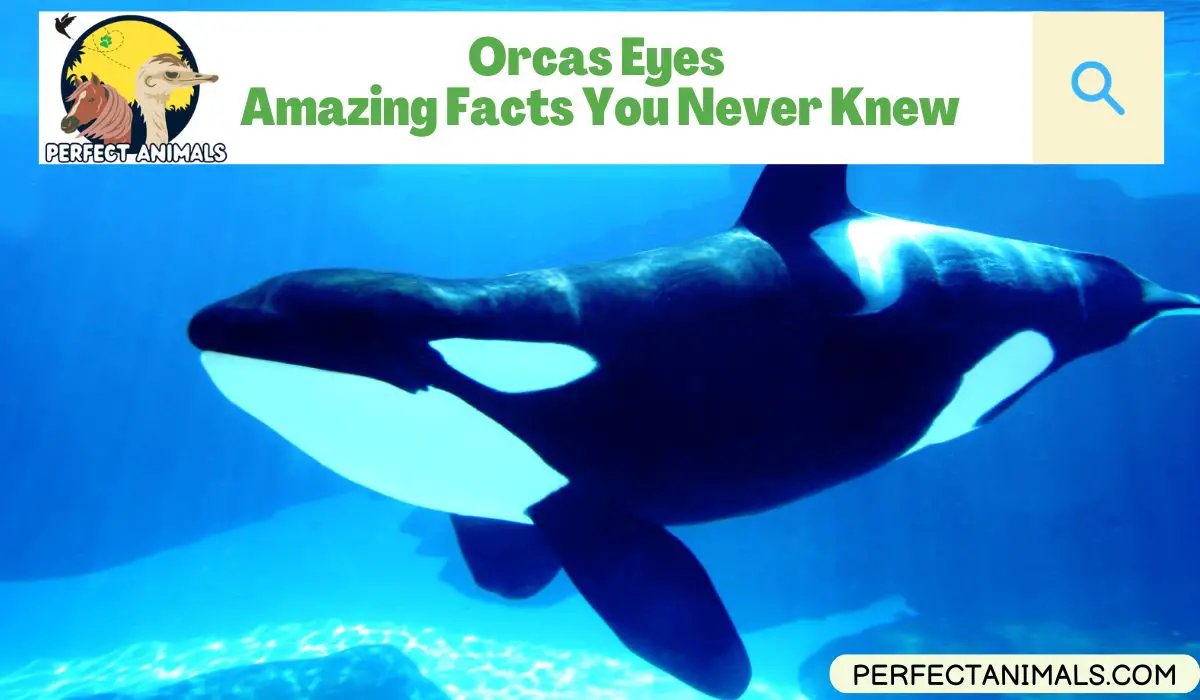Orcas, also known as killer whales, are instantly recognizable by their distinctive black-and-white coloring.
But have you ever taken a close look at an orca’s eyes? With their small, beady eyes set against black skin, an orcas eyes may not seem remarkable at first glance.
However, their eyes reveal fascinating facts about how these apex predators see the world.
In this article, we’ll deeply dive into the orca’s eye. We’ll explore what orca’s eyes look like, why they are so small, their color perception, the purpose of the white eye spots, and more.
Read on to learn all about the visual capabilities of these kings of the ocean and how their eyes have adapted to suit their role as skilled hunters of the sea.
What Do Orcas Eyes Look Like?
Orcas have small, spherical eyes positioned on either side of their large bulbous heads. Their eyes are set wide apart to give them excellent peripheral vision for spotting prey.
The actual eyeball of an orca is quite small compared to their overall body size, only about the size of a cow’s eye. The eyes are dwarfed by the black eyepatch that surrounds each eye.
Related Article – Do Orcas Eat Polar Bears?
Can Orcas See Colors?
There has been much debate around whether orcas can see color or if they only see in black and white.
Due to the lack of certain cones and receptors that enable color vision in other animals, many researchers believe orcas are color blind.
It’s theorized that all cetaceans, the group including whales and dolphins, lack visual pigments sensitive to colors in the blue-green spectrum.
This means they may only see the ocean in shades of gray.
However, some studies indicate orcas may have limited color vision. They may be able to distinguish between certain hues, particularly colors in the blue range.
This may help them spot fish and marine mammals in the ocean using color contrast.
However, the consensus among most scientists is that orcas lack full, robust color vision.
Their ocean environment simply does not require advanced color differentiation like land animals need.
So while not completely color blind, orcas do not see a vibrant, colorful reef the way we do. Their world appears largely in spectrums of gray.
Related Article – How Many Eyes Does An Octopus Have?
Why do Orcas Have White Eye Spots?
As we explained above, orcas have distinctive white oval spots located above each eye.
These markings are known as eye spots or eye patches. The eye spots are simply a natural part of the orca’s coloration.
The primary purpose of the white eye spots is believed to be camouflage.
When viewed from above, the white spots help orcas blend in with the sea floor and avoid being easily spotted by prey.
From below, the spots mimic rays of sunlight filtering down through the water. This makes the large whale appear less conspicuous.
Additionally, the spots help break up the orca’s body outline, disguising their distinctive shape. This makes it harder for prey to detect them and helps orcas remain stealthy hunters.
The unique pattern of white spots on each orca may also facilitate recognition and social interactions among pods.
Scientists theorize the spots aid with identifying individual whales and interpreting body orientation in dark or murky conditions.
You May Also Like – Do Barracudas Eat Fish Eggs?
Why do Orcas’ Eyes Turn Red?
Orcas have a unique reaction – their eyes can turn bloodshot red when they become emotionally aroused or excited.
This reddening occurs when blood vessels rapidly expand in the white sclera part of the orca’s eye.
Scientists have observed orcas with bright red eyes when they are being aggressive with other whales.
Red eyes are also seen when they are actively hunting or have just completed a kill.
The thrill of the hunt likely gets their blood pumping, resulting in expanded blood vessels.
Male orcas courting females have also been documented with red eyes, suggesting they are in a simulated emotional state.
New mothers watching over calves also often exhibit this eye reddening as they are attentive and alert to their newborn’s needs.
So while an orca with red eyes may look fierce or alarming, it is simply an indicator of high emotion and not necessarily aggression.
Those bright red eyes reveal when killer whales are feeling thrilled, amorous, protective, or stimulated by their surroundings.
You May Also Like – Do Penguins Have Tails?
Why Do Orcas Sleep with One Eye Open?
Orcas have the fascinating ability to sleep with just half of their brain at a time. This is called unihemispheric sleep and is also found in other marine mammals like dolphins.
The reason behind this unique sleep adaptation is that orcas need to be conscious to control their breathing.
Unlike humans, they do not breathe automatically and have to actively decide when to take a breath.
If they fell into a deep unconscious sleep, they would drown or suffocate.
To get around this issue, orcas developed the ability to rest only one brain hemisphere at a time.
One side sleeps while the other remains alert to continue breathing and watching for threats. The whale’s eye corresponding to the awake hemisphere will be open during this lighter sleep state.
The orcas alternate which side sleeps to eventually rest both hemispheres. While awake, the brain tells the body when to rise to the surface for air.
Orcas sleep swimming slowly near the surface in pods for protection.
You May Also Like – Do Sharks Travel in Packs or Alone?
Final Thoughts
At first glance, the small, dark eyes of orcas may not seem remarkable compared to the rest of their imposing physique.
However, further examination reveals the eyes are complex organs uniquely adapted to the orcas’ underwater lifestyle.
The location and pigmentation of orcas’ eyes allow for enhanced vision in deep, dark waters to better hunt prey.
Their dual-hemisphere sleeping pattern keeps one eye open to consciously control breathing.
And the bloodshot red eyes that signal emotional states provide a window into the inner lives of these intelligent creatures.
Even the simple white eye spots that first draw our attention speak to the evolutionary needs of orcas.
Camouflage, communication, and recognition of pod members are all aided by this distinctive facial marking.
FAQs
Where are a killer whale’s eyes located?
Orcas have small round eyes located on either side of their large bulbous heads. Their eyes are set wide apart which gives them excellent peripheral vision to spot prey.
Why are orca eyes so small?
Orca eyes are small in proportion to their body size, only about the size of a cow’s eye. Their small eye size is an adaptation to underwater vision and reduces glare that could scare prey.
Can orcas see colors?
Most researchers believe orcas are generally color-blind. They lack certain cones and receptors that allow for full-color vision.
However, some studies indicate they may distinguish limited colors, especially blue hues. But their vision predominantly consists of shades of gray.
Resources – (for further reading)
NOAA Ocean Exploration (.gov) – ORCA’s Eye-in-the-Sea – NOAA Ocean Exploration
Enchanted Learning – Orca, Killer Whale: ZoomWhales.com
National Marine Mammal Foundation – KILLER WHALE

Sofi has worked as an educator at the Miami Seaquarium, where she conducted educational programs about marine life. In her free time, she contributes to our platform, sharing her passion for marine ecosystems and their conservation.

